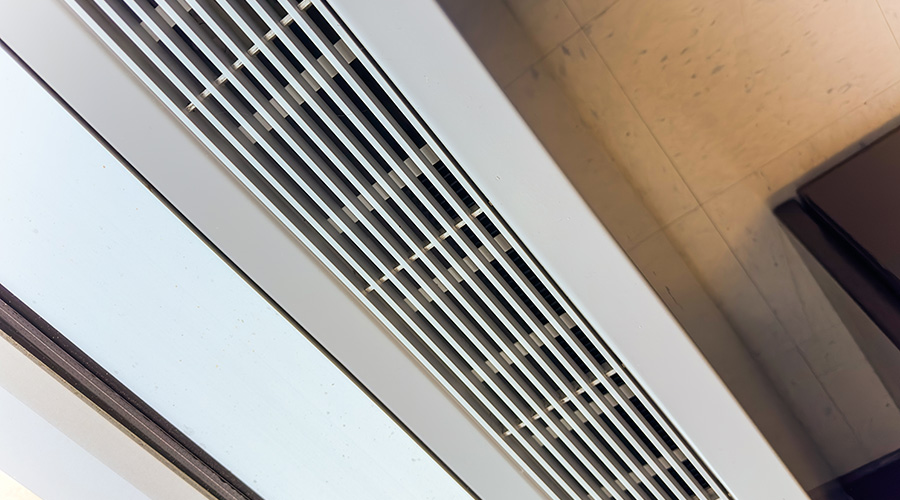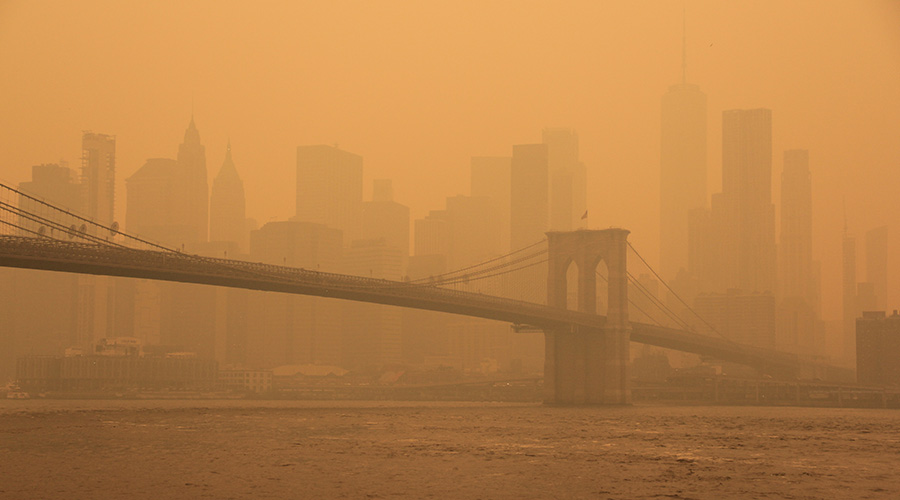A Win-Win for IAQ
Often overlooked, insulation can help facilities improve their indoor air quality and maximize energy efficiency
in conjunction with the North American Insulation Manufacturers Association
The growing concern over indoor air quality (IAQ) has led maintenance and engineering managers to focus on HVAC systems in trying to find ways to improve facility IAQ. Air filtration, outdoor-air ventilation rates and humidity control are important aspects of providing building occupants with healthy IAQ.
One building component that is often overlooked when searching for ways to improve IAQ is insulation. While other common methods used to help improve IAQ are active, insulation is a passive element. It requires no use of energy in order to gain the benefit. In fact, using insulation saves energy, making it a win-win solution. While insulation can help with several aspects of IAQ, it is most effective in limiting the growth of mold, frequently considered one of the most serious forms of IAQ.
Mold growth requires five ingredients — organic nutrients, moisture, a surface to grow on, spores and an appropriate temperature range. Unfortu-nately for maintenance managers, all of these ingredients exist in most facilities. Fortunately, one ingredient is relatively easy to control — moisture. And insulation is one of the most effective tools in controlling moisture levels in buildings and components.
Insulation helps to keep temperatures within buildings constant. When installed with a vapor retarder, it helps reduce the amount of moisture that can migrate into a building from the outside. Installed on piping and mechanical systems, it helps reduce the amount of condensation that forms on cold surfaces within a building, another major source of moisture.
An added benefit is that insulation will improve the energy efficiency of the building and its mechanical systems. Insulation installed in walls decreases energy loads by reducing the building's heating-season heat loss and the cooling-season heat gain. Insulation installed on HVAC system components also improves their energy efficiency by reducing heating-system heat losses and cooling-system heat gains. Similarly, insulation installed on piping systems improves their thermal efficiency. This dual benefit of improving energy efficiency while helping to maintain good IAQ makes insulation so effective.
While many different applications exist for insulation within buildings, the three that are most effectively used in IAQ applications are building exterior, HVAC duct, and pipe insulation.
Building Exteriors
Exterior insulation is widely recognized for its ability to improve thermal efficiency, resulting in reduced energy use. It is not so widely recognized, however, for its ability to improve building IAQ. In fact, it is often wrongly blamed as a cause of IAQ problems.
One misconception is that new buildings are so well insulated that they cannot breathe. As a result, many new buildings have too little air infiltration, allowing contaminants to build up to the point where they become an IAQ concern.
In reality, reducing the rate of infiltration has little to do with contaminants in non-residential buildings. HVAC systems in institutional and commercial facilities are designed to bring in the required levels of fresh air. Their rate at which air enters the building is far greater than would have been introduced through infiltration in older building designs. Any change in contaminant concentration levels due to reduced infiltration rates resulting from insulation buildings is minimal. If anything, the levels are reduced because, unlike air from infiltration, all HVAC system air is filtered and conditioned.
Another common myth regarding exterior insulation is the way it reduces IAQ problems. Some believe limiting thermal conductivity through exterior walls reduces the impact of contaminants on IAQ problems.
In fact, while insulation can help reduce IAQ problems, it is not the thermal conductivity of the insulation that is responsible for the improvement. Rather, it is the vapor retarder portion of the insulation that leads to the improvement.
During the heating season, moisture present in the occupied space migrates through exterior walls. At some point, it reaches the dew point temperature, where the water vapor in the air condenses. A vapor retarder on the interior surface of the insulation prevents the moisture from reaching this point. Without the retarder, the moisture would condense, creating conditions in which mold spores could grow.
Most climates require a vapor retarder on the interior side of the insulation. Local building departments can provide guidance on the proper placement of the vapor retarder for the specific climate zone. In some areas, a vapor retarder might not be added.
HVAC Ducts
For many years, building HVAC systems were designed using ductwork with interior insulation lining. Using this insulation improved the thermal efficiency of the ductwork while reducing noise transmission to occupied spaces. The insulation performed well in most applications, but when the system was not maintained properly, mold grew on the insulation, as it would any surface in the duct. Insulation sometimes came to be seen as a cause of mold, when in reality, it was an innocent bystander.
The air in HVAC system ducts can contain high levels of moisture. Under certain conditions, this moisture can condense on the ducts’ interior surfaces, where accumulations of dust and dirt help to create the conditions that induce mold growth. New-style insulation minimizes this problem by using a coated or mat-faced surface that is better able to resist accumulation of dirt and debris. Dirt still can accumulate on the surface, but at a much lower rate, reducing the risk of mold and bacteria growth.
Also, many types of insulation now are treated with anti-microbial agents to comply with the standards set forth by the American Society for Testing and Materials International for mold and bacteria growth. The best way to ensure that an HVAC system will perform as intended is to follow a regular maintenance schedule.
For existing installations where fiberglass insulation is exposed directly to the air flow, managers can take several steps to reduce the risk of developing IAQ problems. They can start by ensuring that system air-flow rates are within the design range. Higher-than-normal air-flow rates increase the risk of carrying water from the system's cooling coil downstream into ductwork.
Managers also might want to consider installing a hard-surfaced liner in the ductwork, particularly in the section immediately downstream from the cooling coil. Maintenance technicians should regularly inspect of the ducts’ interior sections for early detection of dirt and moisture buildup.
To further reduce the chances of developing an insulation IAQ problem, some technicians have begun experimenting with an ultraviolet lighting system on the duct side of the heating and cooling coils, which some believe will help destroy most of the organisms in the air stream. Debate continues among microbiologists and building scientists about the potential benefit from such a system.
Pipe Insulation
While managers understand the importance of keeping the insulation on building piping systems in good condition in terms of energy conservation, too many managers fail to realize that damaged or missing insulation on these piping systems can harm IAQ. Insulation on these piping systems serves two primary purposes — reducing heat gain or loss by the piping and preventing condensation. For systems carrying building heating water, steam, or domestic hot water, the surface of the system piping is above the ambient temperature, and condensation on the outer surface of the piping will not take place.
But for piping systems carrying chilled water or even domestic water, the temperature difference between the pipe surface and the surrounding space can result in moisture condensing on the surface of the pipe. This condensation accelerates the corrosion of the piping components and can result in moisture dripping onto other building components, creating the conditions that promote the growth of mold.
Any damage to the pipe insulation can allow moist air to gain access to the piping and form condensation. Missing sections of insulation, gaps between adjacent sections or torn sections can allow condensation to form.
Additionally, it is important to maintain a continuous vapor retarder on the exterior surface of the insulation. The proper thickness of insulation is another factor to consider, since too little insulation can allow the pipe to reach a temperature where condensation can occur. And once moisture starts condensing, it can migrate along the insulation, decreasing its thermal efficiency, allowing even more condensation.
Because most piping is installed behind walls or above ceilings where it cannot be inspected easily, finding damaged areas can be difficult. So during construction and renovation projects, all pipe insulation must be inspected thoroughly before the space is sealed. In areas where technicians can access pipes, insulation should be inspected at least every two years, if not annually.
Additional inspections should follow the completion of any work performed on the piping system or to other building systems and components in the vicinity of the piping. Maintenance personnel should carefully monitor the condition of ceiling tiles under piping systems. Stained areas might indicate condensation from piping systems.
Maximizing Benefits
If building insulation is to be effective in reducing energy requirements and helping improve building IAQ, it must be installed properly. Loose sections of insulation, gaps between adjacent sections or damaged components can reduce insulation’s thermal efficiency. Equally important, these same installation deficiencies can lead to the formation of condensation and eventually to the growth of mold and bacteria, prime contributors to building IAQ problems.
While having the insulation properly installed is the necessary first step, managers must also make certain that insulation is maintained properly. Construction and renovation projects can easily disturb or damage installed insulation. Floods from roof leaks or building equipment failures can soak insulation, destroying its thermal efficiency and mechanical integrity.
Before any construction or renovation project is completed, all insulation should be closely inspected for damage. Similarly, after every leak or flood where insulation is exposed, all damaged insulation should be removed and replaced. Good installation and maintenance practices can help ensure that building insulation does not contribute to building IAQ problems.
Spotlight: NAIMA
The North American Insulation Manufacturers Association (NAIMA) is a trade association of manufacturers of fiber glass, rock wool, and slag wool insulation products. NAIMA promotes energy efficiency and environmental preservation through the use of these insulation products, while encouraging their safe production and use.
NAIMA is recognized as the voice of the industry for architects and builders; design, process and maintenance engineers; contractors; codes and standards organizations; government agencies; and homeowners. It advocates for stronger building and energy codes and standards.
The association has provided and maintains research on the health, safety and benefits of glass, rock, and slag fibers, and it disseminates the results to government agencies, the industry at large, customers, contractors, employees, and the general public. NAIMA also publishes literature on product performance, installation guidelines, energy-saving tips, insulation needs, building code guidance, and general health and safety aspects of insulation products.
Promoting worker safety and educating contractors and consumers of the proper ways to install insulation is a top priority for the association. NAIMA manages a detailed training effort across markets. It sponsors and develops training initiatives at technical schools, community colleges, engineering schools, and for regional code officials and industry partners.
For more information online, visit NAIMA, Simply Insulate and 3E Plus Insulation Thickness Computer Program.
|
Related Topics:











